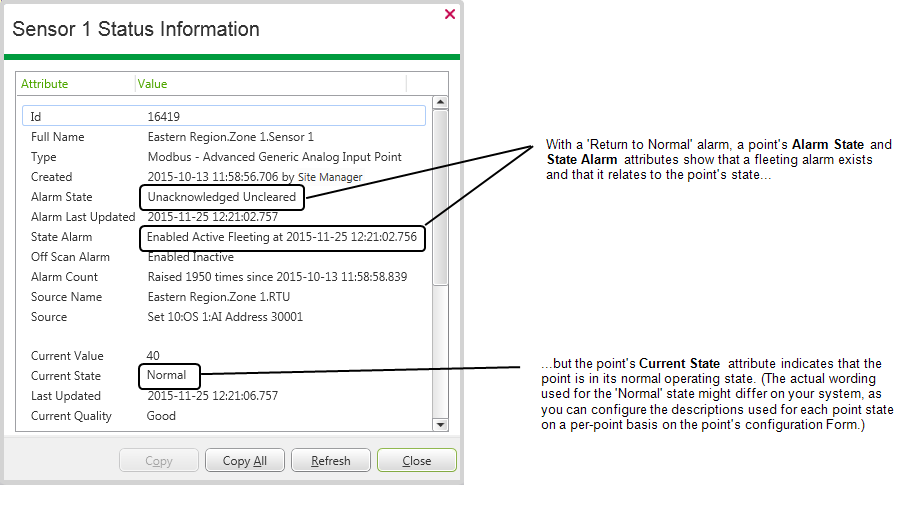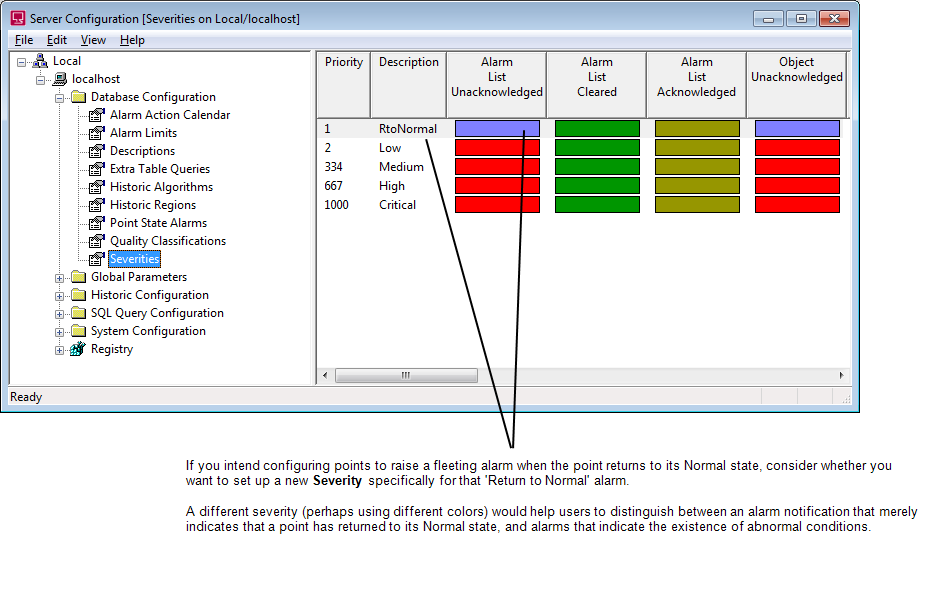Return to Normal Alarm
Digital points and some types of analog and counter-type points support the ability to raise an alarm when the point's value returns to that point's normal operating state or range of values. With analog and counter-type points, the alarm comprises a fleeting alarm. This feature can be useful if you want users to be made aware of when a point has returned to its normal state, or you want to use that alarm notification for other functions, for example in Logic programs, or to trigger or cancel alarm redirections. Be aware, however, that configuring such points to raise an alarm when their values return to the normal operating state or range of values (known as raising a 'Return to Normal' alarm) could potentially impact your operators' ability to distinguish between alarm notifications that indicate an abnormal occurrence, and that of a 'Return to Normal' alarm. This is because both types of alarm trigger the types of activity you expect when an alarm is raised (see Activities that Occur when an Alarm is Raised). For example, by default the alarms appear in the Alarm Banner and Alarms List, and the relevant animated objects on Mimics change to show that an alarm has been raised. Likewise, the point's Status display shows that the point is in an alarm state, however with a 'Return to Normal' alarm, the Status display also indicates that the point is in its normal operating state.

We recommend that you only configure points to raise an alarm when their values return to the normal operating state or range of values if such a notification is specifically required on your system.
If you do use this feature, consider whether to configure 'Return to Normal' alarms in such a way as to clearly distinguish them from other types of alarm. For example, by creating and using a Severity level specifically for such alarms, and configuring that Severity level to use different colors to other alarms on your system. This will enable users to clearly distinguish between alarm notifications that indicate an abnormal occurrence, and those of a 'Return to Normal' alarm. You define Severity levels using the Geo SCADA Expert Server Configuration Tool (see Alarm and Event Severities).
If you use a different Severity specifically for 'Return to Normal' alarms, consider whether to apply an Alarm Filter to the User accounts of those users that do not need notifying of 'Return to Normal' alarms. By configuring the filter to omit alarms of that particular severity, 'Return to Normal' alarms that are assigned that severity would be omitted from Alarms Lists and the Alarm Banner while that user is logged on. For information about configuring alarm filters, see Define the Default Alarm Filter Settings for a User. For an example that demonstrates the use of a custom Severity level specifically for 'Return to Normal' alarms, see the Area of Interest example, below.

If the Area of Interest feature is enabled on your system, you might want to consider using the feature in such a way that only the relevant users are made aware of 'Return to Normal' alarms. As with other state-related alarms and events, you can specify the Area of Interest with which a point's Normal state alarms or events are associated. With such configuration, users will only be aware of the alarms and events to which they are allocated Area(s) of Interest. For more information, see Restrict Alarm and Event Access to Specific Areas of Interest. For an example that demonstrates how you might configure a different Area of Interest for alarms that are associated with a point's Normal state, see Use Multiple Point State Alarms in Conjunction with Areas of Interest (the example is specific to points that are configured to have Multiple Point State Alarms).
As with other alarms, 'Return to Normal' alarms are affected by other configuration, including (if applicable to the points', or your system's configuration):
- Hysteresis—Some analog points support a Hysteresis feature in relation to Alarm Limits. You use the feature to specify the minimum value change that has to occur before Geo SCADA Expert clears the limit alarm. The feature helps to ensure that Geo SCADA Expert does not continuously raise and then clear a point's alarms while the point's value fluctuates around an alarm limit. You specify the Hysteresis amount on the relevant Point Form (see Specify the Hysteresis - the Minimum Value Change that can Clear an Alarm).
- Persistence—If supported by the point, you can configure Geo SCADA Expert to only update a point's change in state once that point has remained in the state for a specified amount of time. With such configuration, you can apply persistence to the Normal state, so that Geo SCADA Expert only raises 'Return to Normal' alarms once a point has returned to the Normal state for a specified amount of time. For more information, see the point configuration section in the relevant driver guide.
- Alarm Suppression—If configured to do so, the occurrence of a 'Return to Normal' alarm on a parent database item will trigger alarm suppression on child database items, until that alarm clears or is acknowledged. Likewise, if a parent database item is triggering alarm suppression, and a child database item raises a 'Return to Normal' alarm, that alarm will be suppressed while the parent suppression (or any associated Unsuppress Delay)remains active. For more information, see Alarm Suppression.